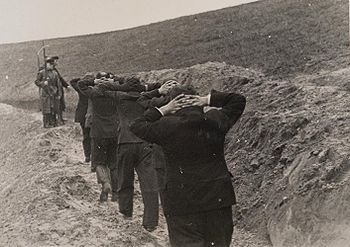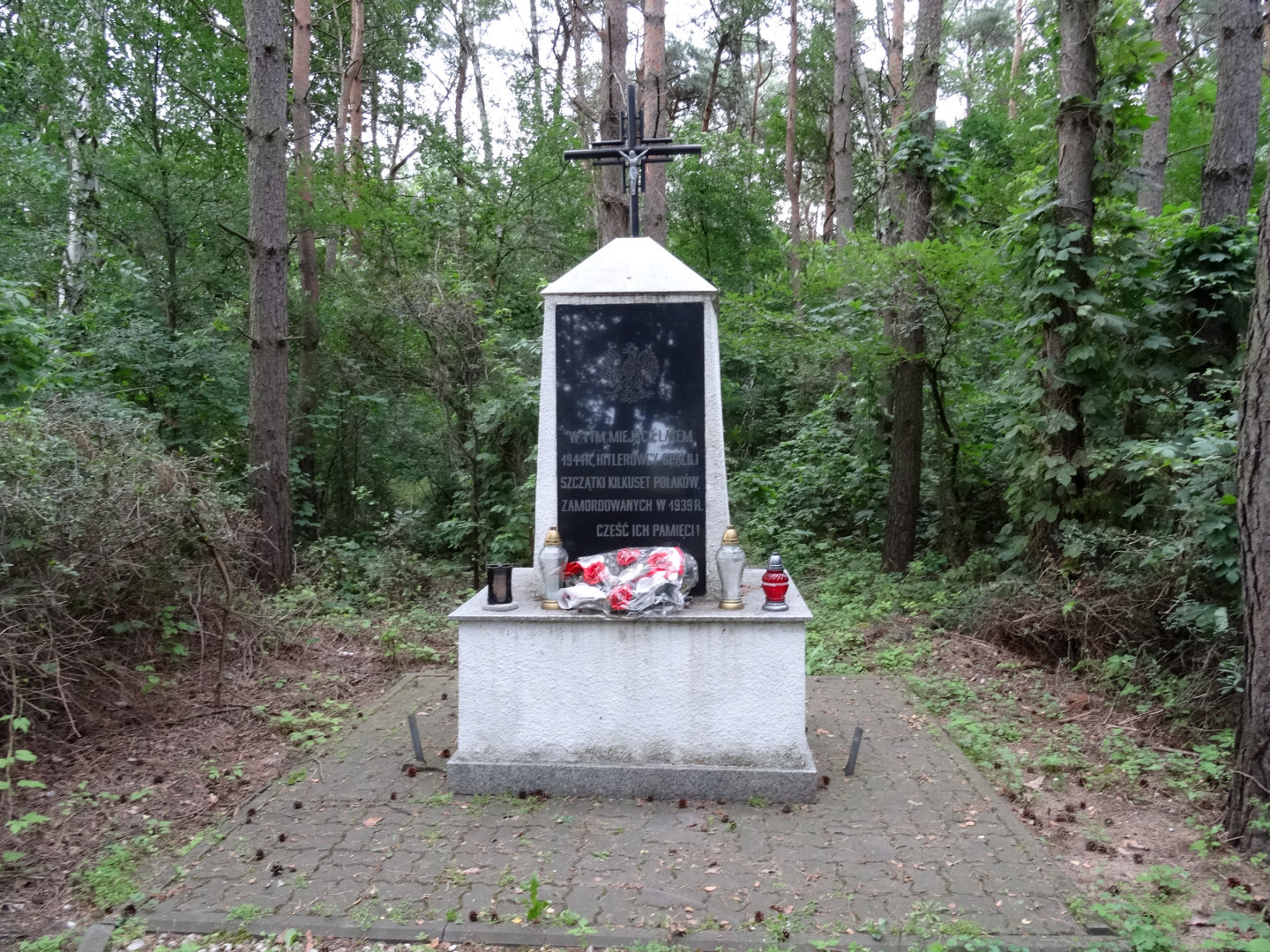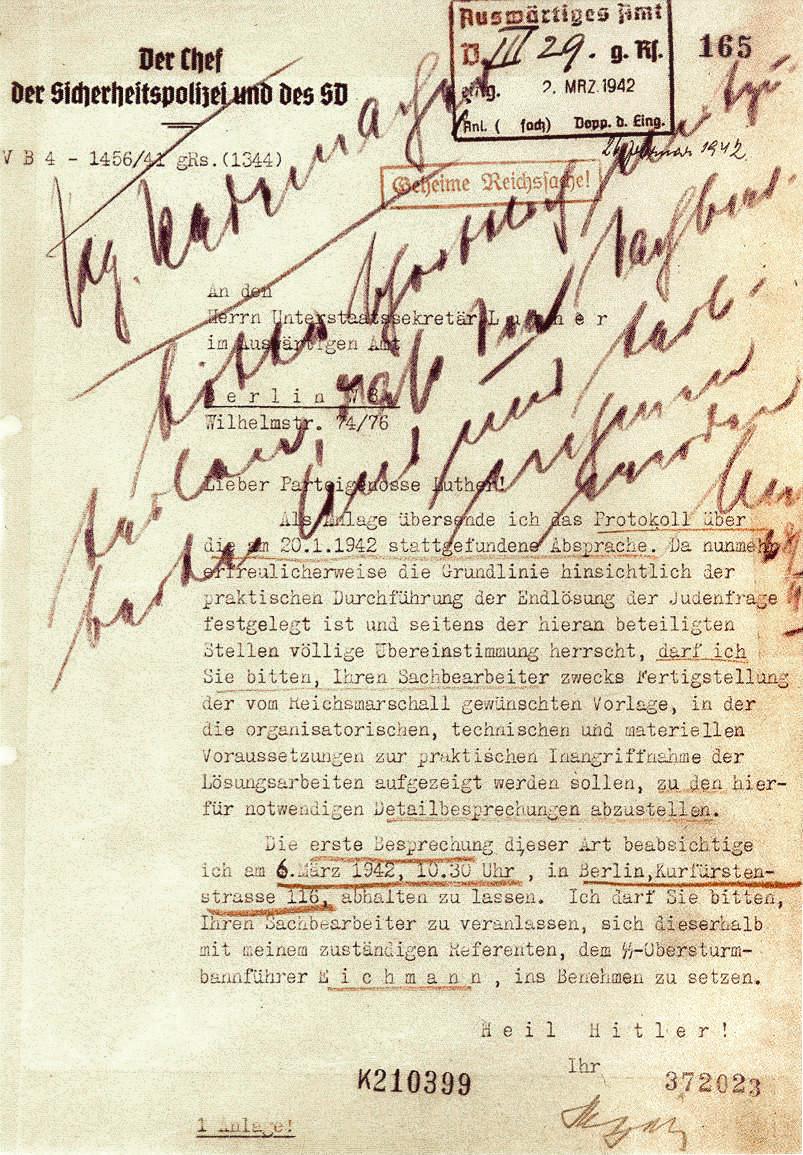|
Executions In The Valley Of Death
Executions in the Valley of Death were a series of mass executions carried out by German occupiers in a valley near the town of Fordon, Bydgoszcz, Fordon (now a district of Bydgoszcz). In this location – later called the Valley of Death (Bydgoszcz), Valley of Death – paramilitary members of the ''Volksdeutscher Selbstschutz'' and officers of the ''Einsatzgruppen'' murdered between 1,200 and 3,000 residents of Bydgoszcz and nearby localities in the autumn of 1939. Most of the Valley of Death victims were members of the Polish and Jewish intelligentsia, as well as Catholic clergy. Fordon's Valley of Death is the largest mass grave in Bydgoszcz and serves as the most well-known symbol of the martyrdom of the city's inhabitants during World War II. ''Intelligenzaktion'' in Bydgoszcz In the initial months of the German occupation, Pomerania was the region of Poland where Nazi terror took its most brutal form. Even against this background, the German repressions against the popu ... [...More Info...] [...Related Items...] OR: [Wikipedia] [Google] [Baidu] |
Fordon, Bydgoszcz
Fordon, is a district in Bydgoszcz, Poland, located in the north-eastern part of the city, with some 75,000 inhabitants. Currently, Fordon is the biggest district of Bydgoszcz. House estates Fordon is subdivided into 16 house estates: * Stary Fordon * Akademickie * Bajka * Bohaterów * Eskulapa * Kasztelanka * Łoskoń * Mariampol * Nad Wisłą * Niepodległości * Pałcz * Powiśle * Przylesie * Szybowników * Tatrzańskie (Bydgoszcz district), Tatrzańskie * Zofin History A settlement in place of Fordon is mentioned in sources for the first time in 1112 as . In those times there was located an important defensive castle which was eventually fired and destroyed in 1330 by the Teutonic Knights. Fordon was a Royal city in Polish–Lithuanian Commonwealth, royal town of the Kingdom of Poland, administratively located in the Bydgoszcz County in the Inowrocław Voivodeship in the Greater Poland Province of the Polish Crown, Greater Poland Province. In the Partitions of Po ... [...More Info...] [...Related Items...] OR: [Wikipedia] [Google] [Baidu] |
Kriminalpolizei
''Kriminalpolizei'' (, "criminal police") is the standard term for the criminal investigation agency within the police forces of Germany, Austria, and the German-speaking cantons of Switzerland. In Nazi Germany, the Kripo was the criminal police department for the entire Reich. Today, in the Germany, Federal Republic of Germany, the state police (''Landespolizei'') perform the majority of investigations. Its Criminal Investigation Department is known as the ''Kriminalpolizei'' or more colloquially, the Kripo. Foundation In 1799, six police officers were assigned to the Prussian ''Kammergericht'' (superior court of justice) in Berlin to investigate more prominent crimes. They were given permission to work in plainclothes, when necessary. Their number increased in the following years. In 1811, their rules of service were written into the ''Berliner Polizeireglement'' (Berlin Police Regulations), and in 1820, the rank of ''Kriminalkommissar'' was introduced for criminal investigat ... [...More Info...] [...Related Items...] OR: [Wikipedia] [Google] [Baidu] |
Bydgoszcz County
__NOTOC__ Bydgoszcz County () is a unit of territorial administration and local government (powiat) in Kuyavian-Pomeranian Voivodeship, north-central Poland. It was created on 1 January 1999 as a result of the Polish local government reforms passed in 1998. Its administrative seat is the city of Bydgoszcz, although the city is not part of the county (it constitutes a separate city county). The only towns in Bydgoszcz County are Solec Kujawski, which lies east of Bydgoszcz, and Koronowo, north of Bydgoszcz. The county covers an area of . As of 2019 its total population is 118,041, out of which the population of Solec Kujawski is 15,652, that of Koronowo is 11,162, and the rural population is 91,227. Politics Voters elect a unicameral Bydgoszcz County Council () consisting of a 21-members. The council is elected under proportional representation in free elections for a 4-year term.. Executive body is county executive board (''zarząd powiatu'') consists of five members elec ... [...More Info...] [...Related Items...] OR: [Wikipedia] [Google] [Baidu] |
Tryszczyn
Tryszczyn is a village in the administrative district of Gmina Koronowo, within Bydgoszcz County, Kuyavian-Pomeranian Voivodeship, in north-central Poland. It lies south of Koronowo and north-west of Bydgoszcz. It is located in the historic region of Kuyavia. History During the German occupation (World War II), in 1939, Tryszczyn was the site of large massacres of Poles from Bydgoszcz carried out by the Germans as part of the ''Intelligenzaktion The ''Intelligenzaktion'' (), or the Intelligentsia mass shootings, was a series of mass murders committed against the Polish people, Polish intelligentsia (teachers, priests, physicians, and other prominent members of Polish society) during the ...''. Among the victims were teachers, activists, priests, old people, and even boy and girl scouts, gymnasium students, and children as young as 12. References Villages in Bydgoszcz County Intelligenzaktion massacre locations {{Bydgoszcz-geo-stub ... [...More Info...] [...Related Items...] OR: [Wikipedia] [Google] [Baidu] |
Otorowo, Kuyavian-Pomeranian Voivodeship
Otorowo () is a village in the administrative district of Gmina Solec Kujawski, within Bydgoszcz County, Kuyavian-Pomeranian Voivodeship, in north-central Poland. It lies west of Solec Kujawski, east of Bydgoszcz, and west of Toruń. It is located in the historic region of Kuyavia. History The earliest mention of the village comes from 1280, when it was part of Piast-ruled Poland. Otorowo was a royal village of the Kingdom of Poland, administratively located in the Bydgoszcz County in the Inowrocław Voivodeship in the Greater Poland Province. During the German occupation (World War II), in October and November 1939, Otorowo was the site of large massacres of hundreds of Poles from Otorowo and other nearby villages, carried out by the German ''Einsatzkommando 16'' as part of the ''Intelligenzaktion The ''Intelligenzaktion'' (), or the Intelligentsia mass shootings, was a series of mass murders committed against the Polish people, Polish intelligentsia (teachers, priests, ... [...More Info...] [...Related Items...] OR: [Wikipedia] [Google] [Baidu] |
Borówno Lake
Borówno Lake is a reservoir lake located in the Kuyavian–Pomeranian Voivodeship, on the , in the Bydgoszcz County, in Gmina Dobrcz, approximately 9 km north of the city limits of Bydgoszcz. Description The lake has an oval shape. A forest complex adjoins it from the northwest, while on the eastern shore, there is a complex of holiday homes. To the south lies the village of Borówno, from which the lake takes its name. In the forest adjacent to the north, there is the , protecting a peatland, alder carr, and a habitat of swamp willow. Two similar lakes, Kusowo and , connect to the north of the lake. The lake basin has a regular shape sloping towards the center, with one central depression measuring 14 m in depth. The lake bed surface below the 12.5-meter isobath constitutes 21% of the total lake area. Small and shallow bays have formed at both ends of the lake. The total length of the shoreline is 3.96 km. The littoral zone of the lake occupies 38% of the entire r ... [...More Info...] [...Related Items...] OR: [Wikipedia] [Google] [Baidu] |
General Government
The General Government (, ; ; ), formally the General Governorate for the Occupied Polish Region (), was a German zone of occupation established after the invasion of Poland by Nazi Germany, Slovak Republic (1939–1945), Slovakia and the Soviet Union in 1939 at the onset of World War II. The newly occupied Second Polish Republic was split into three zones: the General Government in its centre, Polish areas annexed by Nazi Germany in the west, and territories of Poland annexed by the Soviet Union, Polish areas annexed by the Soviet Union in the east. The territory was expanded substantially in 1941, after the German Operation Barbarossa, Invasion of the Soviet Union, to include the new District of Galicia. The area of the ''Generalgouvernement'' roughly corresponded with the Austrian part of the Polish–Lithuanian Commonwealth after the Third Partition of Poland in 1795. The basis for the formation of the General Government was the "Annexation Decree on the Administration o ... [...More Info...] [...Related Items...] OR: [Wikipedia] [Google] [Baidu] |
Sturmbannführer
__NOTOC__ ''Sturmbannführer'' (; ) was a Nazi Party paramilitary rank equivalent to Major (rank), major that was used in several Nazi organizations, such as the Sturmabteilung, SA, Schutzstaffel, SS, and the National Socialist Flyers Corps, NSFK. The rank originated from German Stormtroopers_(Imperial_Germany), shock troop units of the First World War. The Ranks and insignia of the Sturmabteilung, SA title of ''Sturmbannführer'' was first established in 1921. In 1928, the title became an actual rank and was also one of the first established SS ranks. The insignia of a ''Sturmbannführer'' was four silver pips centered on a collar patch. The rank rated below ''Standartenführer'' until 1932, when ''Sturmbannführer'' became subordinate to the new rank of ''Obersturmbannführer''. In the Waffen-SS, ''Sturmbannführer'' was considered equivalent to a Major (rank), major in the German ''Wehrmacht''. Various Waffen-SS units composed of Waffen-SS foreign volunteers and conscripts, f ... [...More Info...] [...Related Items...] OR: [Wikipedia] [Google] [Baidu] |
Gdańsk
Gdańsk is a city on the Baltic Sea, Baltic coast of northern Poland, and the capital of the Pomeranian Voivodeship. With a population of 486,492, Data for territorial unit 2261000. it is Poland's sixth-largest city and principal seaport. Gdańsk lies at the mouth of the Motława River and is situated at the southern edge of Gdańsk Bay, close to the city of Gdynia and the resort town of Sopot; these form a metropolitan area called the Tricity, Poland, Tricity (''Trójmiasto''), with a population of approximately 1.5 million. The city has a complex history, having had periods of Polish, German and self rule. An important shipbuilding and trade port since the Middle Ages, between 1361 and 1500 it was a member of the Hanseatic League, which influenced its economic, demographic and #Architecture, urban landscape. It also served as Poland's principal seaport and was its largest city since the 15th century until the early 18th century when Warsaw surpassed it. With the Partition ... [...More Info...] [...Related Items...] OR: [Wikipedia] [Google] [Baidu] |
Sicherheitspolizei
The often abbreviated as SiPo, is a German term meaning "security police". In the Nazi Germany, Nazi era, it referred to the state political and criminal investigation security agency, security agencies. It was made up by the combined forces of the Gestapo (secret state police) and the ''Kriminalpolizei (Nazi Germany), Kriminalpolizei'' (criminal police; Kripo) between 1936 and 1939. As a formal agency, the SiPo was incorporated into the Reich Security Main Office (RSHA) in 1939, but the term continued to be used informally until the end of World War II in Europe. Origins The term originated in August 1919 when the ''Reichswehr'' set up the ''Sicherheitswehr'' as a militarised police force to take action during times of riots or strikes. Owing to limitations in army numbers, it was renamed the to avoid attention. They wore a green uniform, and were sometimes called the "Green Police". It was a military body, recruiting largely from the ''Freikorps'', with NCOs and officers from ... [...More Info...] [...Related Items...] OR: [Wikipedia] [Google] [Baidu] |
Sicherheitsdienst
' (, "Security Service"), full title ' ("Security Service of the ''Reichsführer-SS''"), or SD, was the intelligence agency of the Schutzstaffel, SS and the Nazi Party in Nazi Germany. Established in 1931, the SD was the first Nazi intelligence organization and the Gestapo (formed in 1933) was considered its sister organization through the integration of SS members and operational procedures. The SD was administered as an independent SS office between 1933 and 1939. That year, the SD was transferred over to the Reich Security Main Office (''Reichssicherheitshauptamt''; RSHA), as one of its seven departments. Its first director, Reinhard Heydrich, intended for the SD to bring every single individual within the Third Reich's reach under "continuous supervision". Following Germany's defeat in World War II, the tribunal at the Nuremberg trials officially declared that the SD was a criminal organisation, along with the rest of Heydrich's RSHA (including the Gestapo) both individually ... [...More Info...] [...Related Items...] OR: [Wikipedia] [Google] [Baidu] |
Schutzstaffel
The ''Schutzstaffel'' (; ; SS; also stylised with SS runes as ''ᛋᛋ'') was a major paramilitary organisation under Adolf Hitler and the Nazi Party in Nazi Germany, and later throughout German-occupied Europe during World War II. It began with a small guard unit known as the ''Saal-Schutz'' ("Hall Security") made up of party volunteers to provide security for party meetings in Munich. In 1925, Heinrich Himmler joined the unit, which had by then been reformed and given its final name. Under his direction (1929–1945) it grew from a small paramilitary formation during the Weimar Republic to one of the most powerful organisations in Nazi Germany. From the time of the Nazi Party's rise to power until the regime's collapse in 1945, the SS was the foremost agency of security, mass surveillance, and state terrorism within Germany and German-occupied Europe. The two main constituent groups were the '' Allgemeine SS'' (General SS) and ''Waffen-SS'' (Armed SS). The ''Allgemeine ... [...More Info...] [...Related Items...] OR: [Wikipedia] [Google] [Baidu] |






